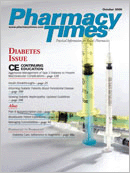Publication
Article
Pharmacy Times
case STUDY
Author(s):
CASE ONE:While working at Sunny DayPharmacy, the pharmacist isapproached by a woman andher teenage daughter. Thewoman asks the pharmacist ifshe would mind looking at herdaughter's sunburn.
The pharmacist notices thatthe daughter has visible first-degreesunburn on her faceand exposed extremities. Her arms and legs have some second-degree blisters that show early signs of healing.
When the pharmacist questions her about the sunburn, theteenager explains that she developed the sunburn while onvacation at the beach. When questioned about her use of sunscreen,she insists that she applied sunscreen with a sun protectionfactor of 30 each day and would reapply it frequentlythroughout the day. The teenager claims that she usually developsa suntan easily, rarely burning.
The mother asks if the pharmacist has any recommendationsfor an OTC medication to alleviate the sunburn. The pharmacistrecommends ibuprofen to decrease the pain. When thepharmacist takes the teenager to the analgesic aisle, he asksher if she is taking any prescription or OTC medications. Shesays she is just finishing a course of antibiotics. Although shecannot remember the name of the medication, she doesremember that the name "looks like 2 names," and it is a "hugewhite pill."
Considering the severity of the teenager's sunburn, whatantibiotic does the pharmacist suspect she is taking?
CASE TWO:Before morning rounds, themedical resident notes that thephenytoin level for one of thepatients is now in the chart.When he sees that the level wasonly 5.8, he wants to impresshis attending physician by notonly knowing that the level isbelow the therapeutic range, but also by having a plan forincreasing the dose. He asks the pharmacy student to calculatea dosage adjustment, informing the student that he would like tohave the recommendation ready when rounds begin.
The pharmacy student begins reviewing the medical chart forthe patient. He notices that the patient has not had any seizureswhile taking phenytoin 200 mg orally 3 times a day. This morning'slaboratory results also show that the patient's serum albuminwas reported as 2.0 g/dL, while his serum creatinine wasreported as 0.9 mg/dL.
When morning rounds begin, the medical resident asks thepharmacy student to inform the attending physician whatdosage adjustment should be made. The pharmacy studentshocks the resident by recommending that the dose be maintainedat 200 mg 3 times daily. The pharmacist working with thestudent agrees with the recommendation.
Why did the pharmacy student not recommend a dosageincrease?
Dr. Schlesselman is an assistant clinical professor at the University of Connecticut School of Pharmacy.
Click Here For The Answer ----------->
[-]
CASE ONE: The pharmacist suspects the teenager is taking sulfamethoxazole-trimethoprim. Photosensitivity reactions are known tooccur with this medication. The primary treatment is discontinuance of the antibiotic. The reaction will persist 1 to 2 days after discontinuation.
CASE TWO: The pharmacy student made the recommendation because he knew that phenytoin is highly protein-bound. Phenytoin serum assaysmeasure total phenytoin, bound and unbound. Alterations in protein binding must be accounted for when evaluating levels. The student was able toaccount for binding alteration due to hypoalbuminemia using the following equation: adjusted concentration = measured concentration/([0.2 x albumin] +0.1). The pharmacy student also realizes that it is important to treat the patient, rather than the level. Regardless of the levels, the patient has not experiencedany seizures. Increasing the dose would only increase the risk of adverse effects.
toggle(getObject('exp1048685570_link'), 'exp1048685570');







